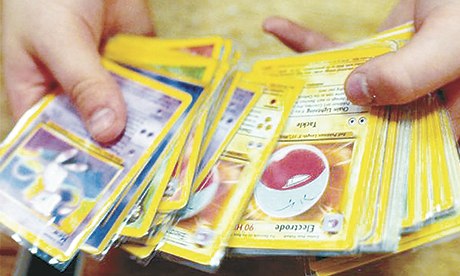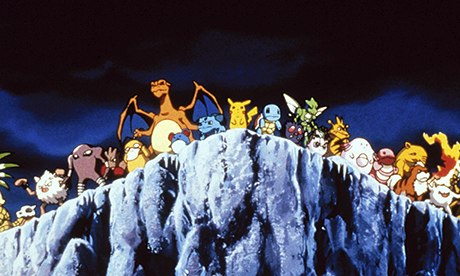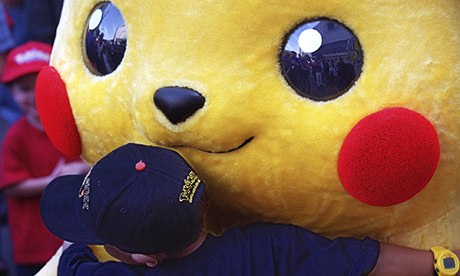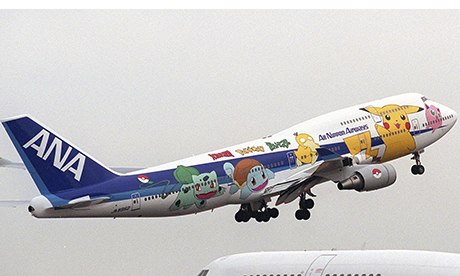
In 1996, the world entered a new Mesozoic Era. One hundred and fifty one bizarre species (everything from foot-high mammals to licking, looming reptiles) emerged from the primordial digital soup to take up residence in our cultural landscape. These pocket monsters, a term contracted for brevity and ease of copyright to Pokémon, were found scurrying about in the tall grass. If captured, they could be disciplined and trained to fight, forming a complicated bond of trust and companionship with their trainer, usually a child, who perhaps for the first time in their life is able to master the monsters, rather than flee them.
Soon enough Pokémon begat Pokémania – spin-off television series and films, trading-card games (to date more than 20bn cards have been sold in 74 countries), websites (pokémon.com, which contains detailed 'Pokéarcana' on more than 640 breeds, offering secrets and techniques necessary to find the rarest creatures, has 2.5 million unique visitors a month), toys – Hasbro paid $325m (£203m) to market these – and even a bricks-and-mortar 'training centre' in New York's moneyed Rockefeller Center.
As of March this year, Pokémon games have combined sales of more than 245m units – a figure set to rise yet further on the release of Pokémon X&Y for Nintendo's 3DS handheld system next month. The young of our species have evidently taken the game's motto to heart; when it comes to Pokémon, humans Gotta Catch/Buy/Love/Obsess Over 'Em All.
Despite the years of acclaim, testified in ever-multiplying billions of dollars of revenue, Junichi Masuda, director of the Pokémon games and co-founder of the franchise's originating video game studio, Game Freak, has an air of bewilderment about him. "I never imagined I'd be in a room like this, speaking to a journalist," he says, as we meet in a merchandise-decorated chamber in the pristine Gore Hotel (which sounds an awful lot like a trainer's curt directive to his Pokémon) in South Kensington, London. Video games came later. As a child, Masuda was an "outdoors" type. He grew up in Osaka, Japan, but spent most of his time outside, on his bicycle, catching insects. "I was almost never at home," he says.
It's a similar picture of childhood to that of his Game Freak founding partner, Satoshi Tajiri, who was also obsessed with catching insects in his youth (Tajiri would explore the fields near his home on the outskirts of Tokyo in search of mini-beasts, carefully studying each one that he caught, before cataloguing it in a notepad bought for him by his parents).

The game of life
Also like Tajiri, Masuda had a deep interest in technology. "Even though I was outside most of the time, I loved playing video games as I grew older, visiting the local arcades and messing around with computers." That interest turned into a hobby when, at middle school, Masuda took apart a synthesiser to see how the musical instrument worked. "That kick-started something in me," he says. "When I was older I'd visit Tokyo's electronics district, Akihabara, and buy parts to make my own effects. I also started dabbling in programming at that time."
This unusual concoction of interests made it difficult for Masuda to find his professional place. After college he worked as a programmer at a computer software firm for 12 months, but this only held a small part of his interest. Around that time, Tajiri (a man who once spent so much money on the arcade game Space Invaders that the owner gave him a cabinet to take home) had become something of a spokesperson for video games in the Japanese national media, defending arcades against a distrusting older generation. Tajiri, who originally wanted to become an entomologist as a way to formalise his fascination with insects, was a moderately successfully writer on video games. In 1982, he had launched a video game magazine called Game Freak with his friend Ken Sugimori, the artist who would eventually draw the Pokémon.
Tajiri and Masuda had a mutual friend and, when he introduced the pair, they became close friends. Writing about games inspired Tajiri to explore making them, and he bought and dismantled Nintendo's Famicom games machine to see if he could work out how to develop for it. When Masuda met Tajiri, he'd already started developing his first game, an action adventure called Mendel's Palace. Tajiri, trusting Masuda, invited his new friend to write the soundtrack to the game. "Every day after work we'd meet up to work on the music, often through the night," he says. "When we finished the game, we decided we should probably set up an actual company. That's how Game Freak started."

Toughing it out
When Nintendo released its Game Boy system, Taijiri imagined digital insects walking along the link cable that could be used to connect two systems. He took the idea to Nintendo who, impressed at his previous game development efforts, offered him a contract. Masuda and Tajiri's shared interest in electronics and insects inspired the initial Pokémon game's design, but while Tajiri was placed under the tutelage of Nintendo's master designer Shigeru Miyamoto, development was difficult. In the six years it took to finish the game, Game Freak nearly went bankrupt on multiple occasions. Five staff quit when the bosses admitted the severity of Game Freak's financial situation.
"It was a difficult time but I never thought about giving up, or throwing it all away," says Masuda, who describes himself as the more practical and logical counterweight to the emotionally driven Tajiri. "You know, when we started work on the game our motivation was never to make money. We just wanted to make the games we were interested in." While the pair missed a number of staff pay cheques, Tajiri would take on writing jobs on the side to help pay the staff. Even so, it was a gruelling time. "We were at the office the entire time," says Masuda. I remember thinking how dumb it was for me to be renting an apartment because I spent so little time there. I was always at the office. We lived in that place."
Between 1990 and 1996, Masuda worked on a number of smaller games alongside Pokémon to help keep the company afloat. By the time Pokémon was ready for release (in two editions, Red and Blue, each with Pokémon unique to the version), the Game Boy was nearing the end of its life cycle. Indeed, the handheld was so outdated by this point, that no magazines would cover the game, and, initially, no toy manufacturer would consider marketing spin-off toys.
But, as with so many of Nintendo's greatest successes, sales continued at a consistent rate, building over a period of months as word of mouth spread. When Tajiri leaked the fact that he had hidden a secret 151st Pokémon in the game, Mew, a character one could only acquire through trading, the rumours streaked across playgrounds and sales doubled.

The sky's the limit
As Pokémon began to sell in significant numbers Nintendo decided to commission an animated television series and, almost overnight, the game turned into a phenomenon. Children would be introduced to the franchise through cartoons, before progressing to trading cards when they were a little older, before, finally, arriving at the video games, which are deep enough to attract not only the young, but also the young at heart, for whom the keen thrill of exploration and collection remains.
For Masuda, the game's ongoing, seemingly limitless appeal is down to the game design itself. "I think the appeal of the characters and the joy of raising creatures, as well as the competitive aspect in the battling, are all key factors in the game's success," he says. "But ultimately the core focus on gameplay is what the franchise is built upon."
Each core Pokémon game casts the player in the role of a young trainer (in the early Japanese versions of the game, the protagonist is called Satoshi), setting out from his parent's house on an adventure. Despite the team's focus on gameplay, the storyline is also a serious consideration, not least because of the vast and impressionable audience.
"Morality in the story is one of the core things I think about when making these games," says Masuda. "I think anyone who has the capacity to play the game will inherently be in a privileged position; they are above a certain level of poverty to even own video games. This means they might be in a more favourable position to change the world when they grow up. In Pokémon, we present an idealistic world. That is there deliberately, in the hope that it inspires our players to be positive influence on their own world."
After all these years working on iteration after iteration, Masuda's enthusiasm for the series has not dimmed. "Usually whenever we near the end of a project I feel like I've done all I can," he says. "I'm out of ideas and I think: 'this could be my last game'. But when the game is released and I start to see how people play, I find new ideas for game features and challenges. It's a cycle: running out of energy towards the end of a project, resting and recuperating and then feeling energised to get back into a new game."
In this sense, Masuda and Tajiri's work is never done. Their great accomplishment is in celebrating the joy of discovery, of offering children, many of whom were born into urban environments, the opportunity to experience the thrill of finding and cataloguing creatures and sharing their experiences with their peers. The visual simplicity belies the game's overarching complexity, whereby a strong Pokémon team consists of tens of thousands of thoughtful decisions, each unique to the player. At this point, however, the series' slogan appears to have been inverted. Now Masuda and Tajiri's directive is aimed outwards, from the designers towards the players as, heart by heart, mind by mind and sale by sale, Pokémon works to catch us all.


Sign up for the Guardian Today
Our editors' picks for the day's top news and commentary delivered to your inbox each morning.
Sign up for the daily email
Source: Tablet Android
0 komentar "Pokémon – from bugs to blockbuster", Baca atau Masukkan Komentar
Posting Komentar